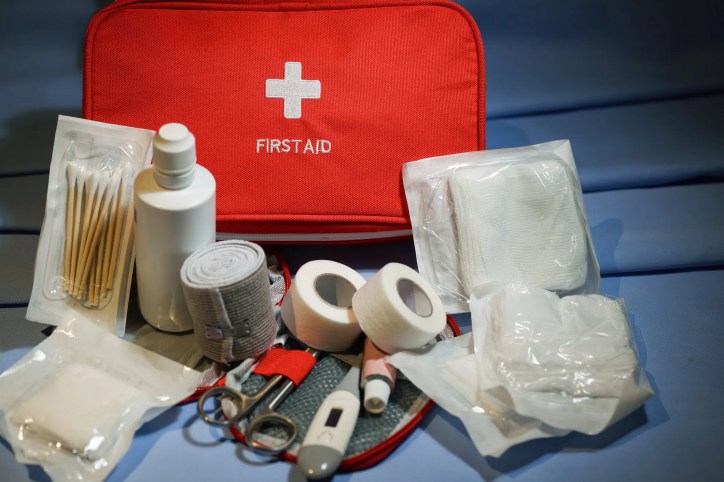Johnson & Johnson invented the first commercial first aid kit in 1888. It was originally created and used for railroad workers who often were injured and consequently needed quick and easy access to basic medical supplies. Over time, the company manufactured bespoke kits for everyone from factory workers to soldiers—and even the Boy Scouts of America. Over a century since its invention, first aids kits are now an indispensable item among households and workplaces, helping treat common injuries quickly.
What Is a First Aid Kit?
Identified with the ISO graphical symbol of a white cross on a green background from ISO 7010, a first aid kit contains supplies to treat minor injuries and illnesses until emergency services or full medical assistance are available. In most kits, there are supplies that can treat common cuts, abrasions, burns, scrapes, and many other ailments. These kits typically come as durable plastic boxes, fabric pouches, or in wall mounted cabinets. First aid kits are incredibly important to have in variety of environments—such as the home, school, the office, or car—because they help reduce the risk of infection or the severity of an injury.
What Should Be in a First Aid Kit?
First aid kits can vary in contents depending on the work environment. A well-stocked first aid kit often includes the following items from these first aid kit categories:
Antiseptics
- Antibiotic ointment or hand sanitizer: a liquid, gel, or foam generally used to kill many viruses/bacteria/microorganisms on the hands.
- Antiseptic wipes: disinfect and sterilize surfaces, equipment, and skin against bacteria, viruses, and fungi.
- Hydrogen peroxide: a mild antiseptic used on the skin to prevent infection of minor cuts, scrapes, and burns. It may also be used as a mouth rinse to help remove mucus or to relieve minor mouth irritation (such as due to canker sores, gingivitis).
Bandages
- Triangular bandages: these non-elastic bandages are used for slings, to hold splints in place, and to restrict movement as well as a pad to control bleeding.
- Elastic bandages: create pressure, hold dressings in place, reduce swelling, and provide some support.
- Roller bandage: secure a dressing in place.
- Adhesive medical tape: attach bandages, gauze, and other dressings to the skin around wounds.
Burn Treatment
- Burn dressing (gel soaked): treat burn wounds and provide first aid relief.
- Burn spray: relieving sprays that help provide relief form minor burns.
- Non-adhesive dressings (e.g., sterile gauze pads) of varying sizes: absorb exudates without sticking to the skin and can be used for extensive surface wounds like burns or abrasions and are often more comfortable to change than adhesive dressings.
Eye Care
- Eyewash bottle: Flush eyes with water or saline solution to remove chemicals, particles, or other substances that may have come into contact with them.
Personal Protective Equipment
- Disposable gloves, preferably made of non-latex material: protect the health of both the first aider and the person being cared for by reducing the risk of infection and cross-contamination.
- Resuscitation mask or CPR face shield: is a one-way valve that can protect the rescuer during first aid, prevents mouth-to-mouth contact.
Miscellaneous
- Instant cold packs: provide a convenient cold therapy that can be used to reduce swelling and relieve discomfort from insect bites to sport injuries.
- First aid guidelines: provide instructions for administering basic medical care in emergencies.
- Foil blanket: reflect and retain body heat to keep people warm in emergency situations.
- Scissors: cut bandages, gauze, tape, and clothing to access wounds.
- Splint: stabilizes and holds a part of the body in place to help it heal after an injury, surgery, or fracture.
- Tweezers: remove debris, such as splinters, ticks, insect stings, and glass. Tweezers are useful because they can carefully pull out debris that might be difficult for a person’s hand to remove without causing further injury.
- Tourniquet: a device used in emergency situations to stop life-threatening external bleeding from limb trauma.
Supplemental First Aid Supplies
Many first aid kits also contain over-the-counter painkillers such as paracetamol, ibuprofen, or aspirin. Aspirin (low-dose) in particular may be lifesaving in an adult experiencing chest pain or heart attack symptoms. Since each work place is unique, here are some other supplemental first aid supplies that ANSI/ISEA Z308.1-2021 considers:
- Adhesive bandages, assorted sizes and styles: Effective to cover wounds of varying sizes located on various parts of the body (knuckle, fingertip).
- Analgesics (oral and/or topical)/anti-inflammatory: Pain management; swelling.
- Electrolyte replacement: Heat-stress related injuries
- Glucose replacement: Diabetic or hypoglycemic episodes
- Face mask, 2-ply, Level 1: Used for pandemic precaution
- Hemostatic agent/dressing: for individuals with compromised clotting or uncontrollable bleeding
- Hydrocortisone: itchiness and skin-related reaction including rashes
- Splinter remover: removing splinters
- Surface disinfecting wipes (EPA approved): helps to disinfect surfaces that may contain harmful viruses such as the common cold, flu, or coronavirus
- Thermometer (disposable): able to determine the risk of transferring infectious diseases worker-to-worker
ANSI Z308.1 Requirements for Workplace First Aid Kids
ANSI/ISEA Z308.1-2021 establishes minimum performance requirements for workplace first aid kits and their supplies. This American National Standard’s requirements are divided into two categories: 1) Class A kits, which are minimum kits for workplaces, and 2) Class B kits, which are for workplaces with a high risk for severe injuries.
ANSI Z308.1 Class A Kits
Class A kits are intended to provide a basic range of products intended to deal with the most common injuries, such as major wounds, minor wounds (cuts and abrasion), minor burns and eye injuries. The required minimum fill of an ANSI/ISEA Z308.1-2021, Class A First Aid kit is detailed in the standard.
ANSI Z308.1 Class B Kits
If a workplace has a high risk of serious injuries, Class B kits are required. ANSI/ISEA Z308.1-2021 details the required minimum fill Class B kits.
